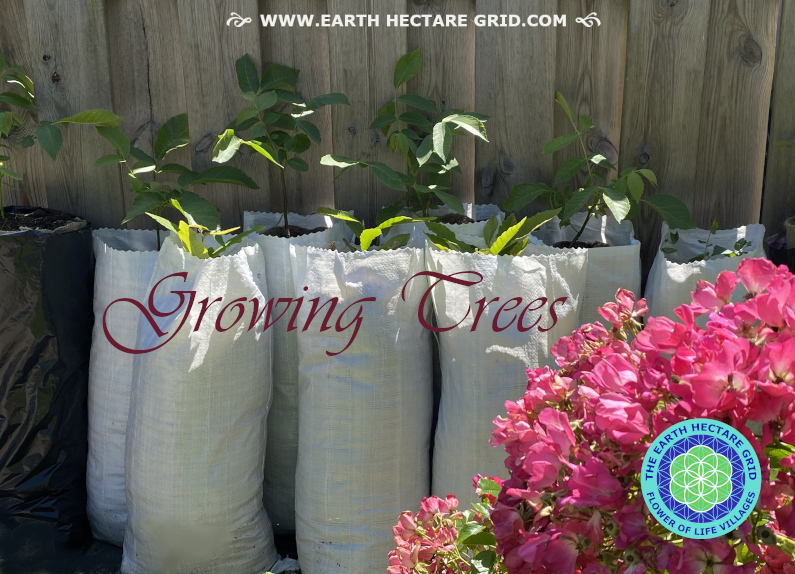GROWING TREES
Here’s how to grow trees. Beware, the author of this article is no expert in the field! So what is the reason for sharing the little bit of knowledge about growing trees?
Well, it can be a quest to find reliable information about it! So could it be because most ‘professional’ tree growers do this to earn a living? Hence they might keep their tree-propagating knowledge a secret?
Then also we’ve found out along the way that most commercial tree growers (in the Netherlands) do patent their trees. These trees are genetically altered. And this is the only way they can make money of selling trees.
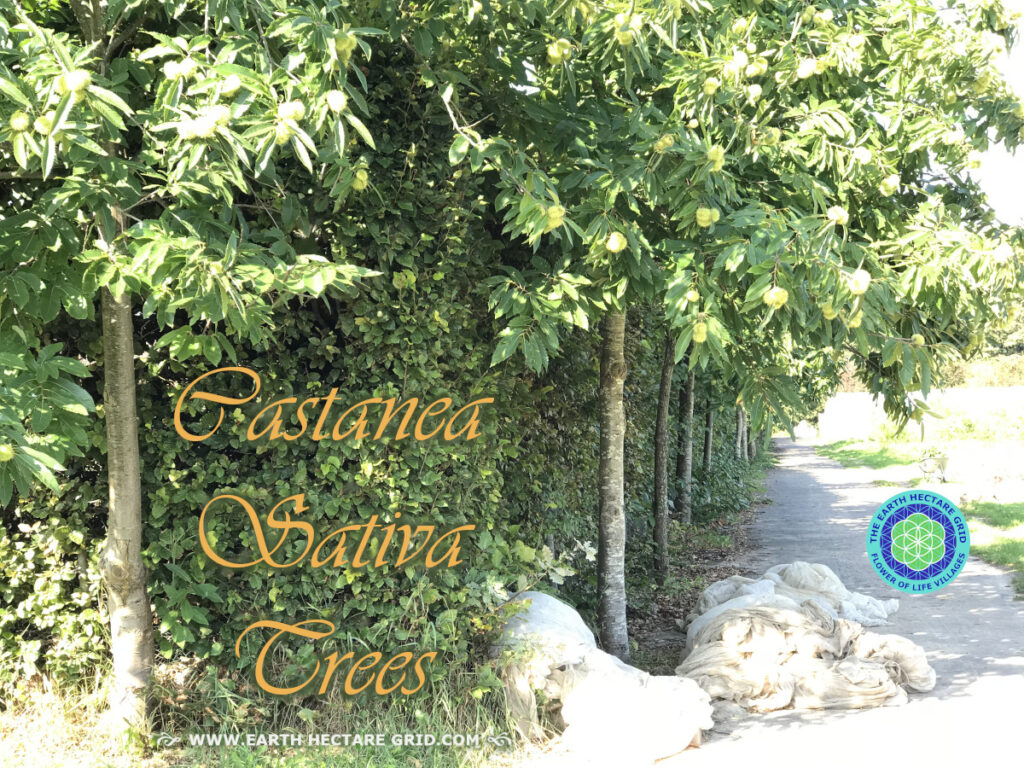
A row young chestnut trees, probably 8 to 10 years old.
Because it is actually forbidden by Dutch law to sell natural tree seeds derived from public lands. And we get that! So we’ll continue in layman’s terms! (this article will be further edited and updated over time, but it is the second week of october already and we need to forage tree seeds!)
MAKING A JUMP START
The most simple way to grow trees is: Collect heirloom seeds from trees, thus know what time of the year you can collect them, put the seeds directly in the soil where you would want a tree to be growing, make sure there are enough hours of sunlight on the spot (5 to 6 hours for a minimum), water regularly in episodes of drought and protect against wind. Wouldn’t it be great if people can make such a jump start with growing trees if they would want to? So here’s the little bit we’ve learned.
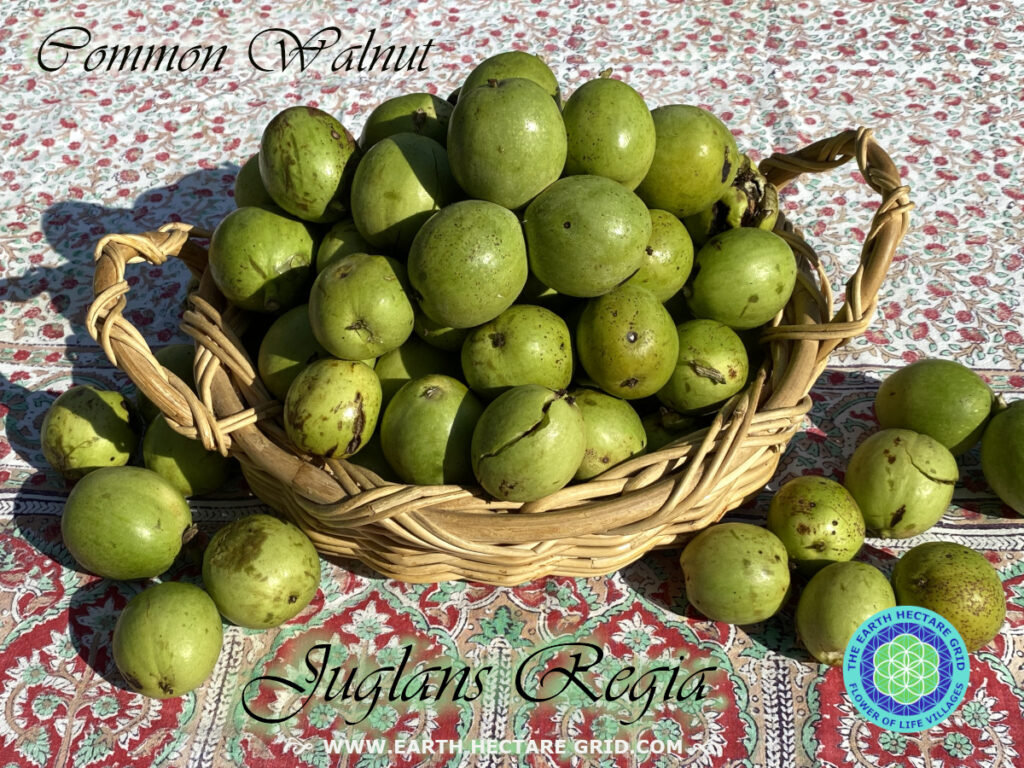
Walnuts in their outer green husk, freshly harvested. After a while the firm husks start to rot, the husk becomes soft and turns black, which by the way can give stains on hands and clothes. It is also possible to peel the walnuts with a sharp knife.
HOW IT STARTED
This is a brief summary of my experience of growing around 30 trees over the last three years in an improvisational manner. The seeds were planted in pots and containers filled with store-bought potting soil. They were placed in a small backyard. Three years later now they are young tree saplings. But from this age onwards they will start groing faster. And their taproots want to grow deeper. So the older ones need to be planted in the ground!
SMALL OUTDOOR SPACE
The trick for these three years was managing the tree saplings in a small outdoor space of which only one third has direct sunlight for 5 to 6 hours. The fences also sometimes blocked sunlight and the tree saplings had to be placed higher on a table or scaffold to still get enough sunlight. I also didn’t really have a comprehensive plan to tackle the design of a tree nursery in my small yard. So it was all very improvisational. Apparently to put the seeds in the tree pots is the least amount of work in the tree growing process!
WHAT HAPPENED NEXT?
From the first year out of the 60 nuts that were planted only a few saplings were left over. What do you think are the reasons for it? First, birds picked the nuts from beneath the soil in the containers. They weren’t covered with mesh cloth. So obviously the birds smell the nuts. Thus how to find ur nuts are gone? It’s when a magpie picks a walnut and flies away with it and one saw that happen. And by that time the harvest season was over…
RAIN AND WIND
The next thing was to find out about the chestnuts which were planted in pots and a few directly in the ground. They were all soaked up at the end of winter by the intense rain we’ve had for weeks. They started deteriorating and were moldy and rotting. So the nuts and saplings needed to be protected from intense rain.

The edible chestnuts are so beautifully designed! They have this cute little tuft at their tips, and such a beautiful maroon color!
The next year I put the chestnuts in pots under tables. The third year I bought transparent tarpaulin and clamps with which I could hand the tarpaulin over the pots.
But strong wind gusts also had something to weigh in. The tree pots had to be displaced several times for the wind could knock them over which might have damaged the tree saplings.
SMALL CRITTERS
Thankfully a few nuts were left, and that first year they sprouted in spring! Thus the saplings needed to be replanted in larger pots. This was followed by an attack on the plants of all kind of small critters who love the young proteïn rich leaves of the saplings.
So the pots had to be covered with mesh cloths again and something had to be invented to spread it over the plants without touching them. So money and time was spend again and some clever thinking about it.
200 FRUIT- AND NUT TREES
Now, you might wonder why in the world would laymen want to propagate trees? Well, this might be for wanting to plant trees on one’s family kin’s domain.

A traditional tree nursery with a translucent roof.
In the Ringing Cedars book series one can read how people start planting trees on their family domains, of which there are about 200 fruit- and nut trees on a hectare of land. I also got the idea to propagate trees in advance. For instance if one has no family homeground yet but can anticipate to get in the nearby future.
NO LAND YET?
The ‘yet’ in the previous sentence is important. Because those who would love to create a family domain, might need some time to find their preferred location. For many in this modern day world it is hard to aquire land. And the candidates might prefer to live in a village setting with neighbouring kin domains.
So there may be a number of years in the start-up phase where it is convenient to start growing trees in the meanwhile as it takes time for trees to develop. Especially the first two to three years the tree saplings stay relativly small and are easily transplanted once the ‘yet’ is there!
Would you -like me-, also love to ponder on the natural green living fence surrounding the hectare, as well as the quart hectare forest? One might want to collect lots of seeds and nuts in advance to make it all happen!
REFORESTATION
And there might be other reasons why one wants to propagate trees. What about wanting to help reforesting areas in one’s vicinity?

Or even wishing for reforestation of our entire planet? The latter is for all those locations where vast natural woods and forests have been burned down through wild fires, or have been cut for timber.
WINTERTIME & GERMINATION
But there are more reasons. One might want to start with growing trees while the ground in wintertime is still frozen. Or one might pre grow trees to test if the seeds will germinate well and create healthy saplings.
THE FIRST CHOICES
For growing trees there are initially three important choices to make:
-
Quality Seeds
-
Direct Seeding
-
Seeding in Pots
QUALITY SEEDS
One has to become knowledgeable about recognizing heirloom trees and seeds.
Many trees nowadays are a mixture of different breeds and genetically manipulated seeds. Such is the case for instance with walnuts and chestnuts and many types of fruit.
Right now there are thousands of people on the internet trying to find out which are the original heirloom quality trees and seeds. So where can you find those trees with the best seeds of primeval heritage and natural origin?
DIRECT SEEDING
Direct seeding means planting the seeds on the spot where you would want to grow a tree. Direct seeding is the best option for growing trees. This is because nature always knows best. The young tree saplings are now connected to the Earth’s magnetism and grow their taproot deep in the ground. Once you see a young tree sapling emerging above the soil, it has developed a root system at least three times as deep as the height of the plant.
But do you have land to start direct seeding nuts and seeds? Is it your own land? Is it an area in your vicinity where the municipality does not immediately mow or cut down everything? Or is there other private land, for instance from farmers or landlords? And do you need to ask permission to plant trees there? And what are the best spots to sow the nuts or seeds?
SEEDING IN POTS
If direct seeding in not yet an option, what pots or containers do you need for growing trees? What is the best quality soil to grow the saplings in? How can I create the best drainage in the pots? Do I have space outside to put the containers, and is there enough sunlight in spring and summer? The tree saplings need at least 6 hours of sunlight a day, but with hot burning weather they need to be in the shade or half shade.
THE FOLLOWING CHOICES
-
Good Quality Soil
-
Preparing Tree Spots
-
Proper Maintenance
GOOD QUALITY SOIL
Have you created your own composted soil? (for instance when you tend an allotment garden). Or do you buy potting soil, or put it together yourself with different ingredients?
PREPARING TREE SPOTS
Once you have aquired a plot of land, where are you going to plant the trees? How much sunshine is on the ideal spot? Will the fruit trees be protected from strong winds? And how do you prepare the ground?
For direct seeding it might be a good idea to work in advance on the spot where you would want to plant the nuts or seeds. One can cut the grass in a circle and put organic compost on it as well as mulch the area. It is also great to determine the distance between all trees in advance, so once the saplings are ready, you can plant them immediately. For low stem fruit trees, distances of 7 meters can be kept. For trees that grow tall such as pines, 8 or 9 meters, while those trees with a very wide canopy such as nut trees, 15 meters might be suitable.
You can plant trees throughout the year, except for the winter months when the ground is frozen. One doesn’t have to plant trees all at once. So one can plant the trees the moment the season has arrived and the saplings are ready for planting.

Hedge from trees as a wind screen for a prune and apple orchard.
PROTECTIVE HEDGE
Fruit growers often have a protective hedge or fence of large trees with dense foliage. They plant this behind in a row to protect the fruit trees next to it from strong winds.
PROPER MAINTEANANCE
Prepare for the elements of nature throughout all seasons, such as intense heat and drought in the summer, or flooding after heavy rain or snow, and big storms with strong windgusts.
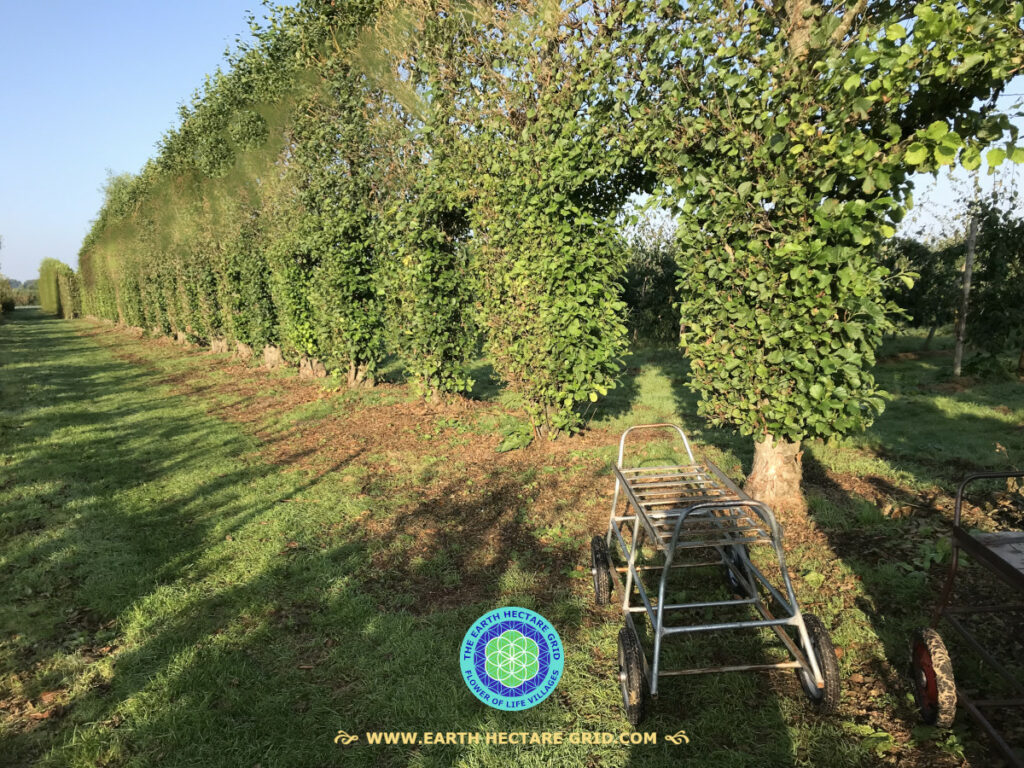
SUPPORT POSTS
Young trees that haven’t deeply rooted yet need support against strong wind gusts. They can be placed between two poles, with a sturdy band around them. That’ll hold the tree in the middle when it is tossed back-and-forth too much by heavy wind gusts.
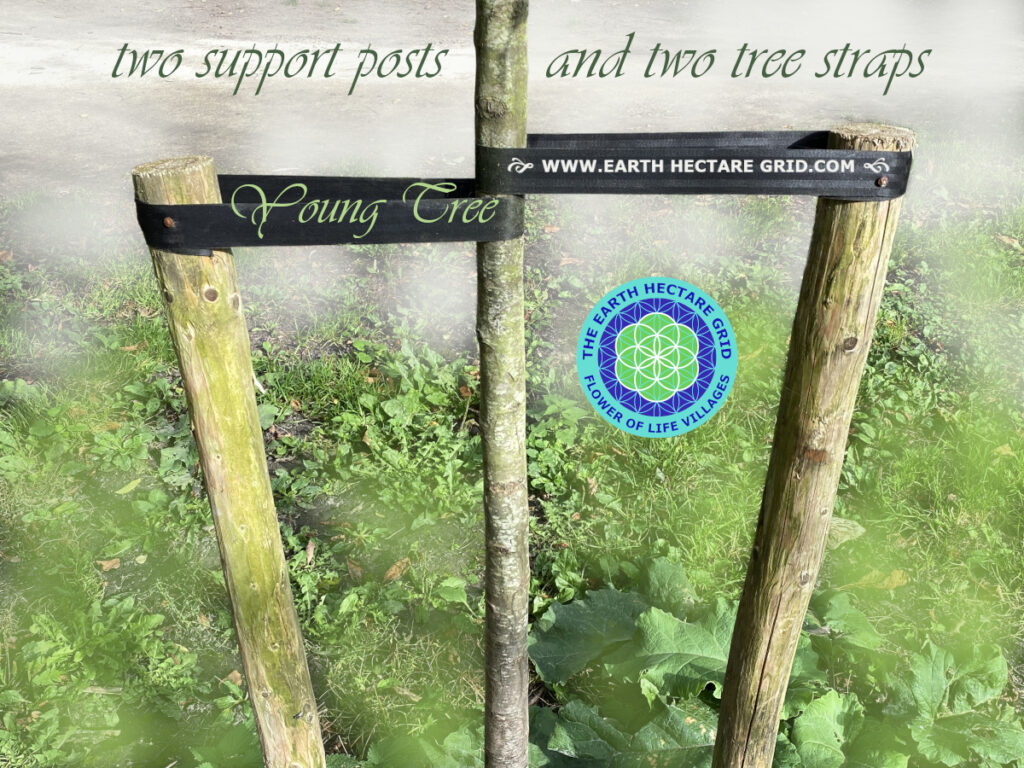
The support poles need to be placed at the same time the tree is planted. When placing the poles later it might damage the trees’ roots.
SMALL CRITTERS AND RODENTS
Prevent rodents, insects, vermin and wild animals from eating the leaves of young saplings. In general, insects and pests will be in the minority if the soil contains sufficient nutrients for the trees.
For instance, snales can be kept away when a few scoops of dried cows- or horse manure mixed with straw and hay, is placed around the young trees. These have nitrogen and potassium which are salty and snales don’t like.
Be careful however with too much of those nutrients, as potassium for instance is a type of salt can burn the plant. It’ll get large brown dried out spots on its leaves and might wither away.
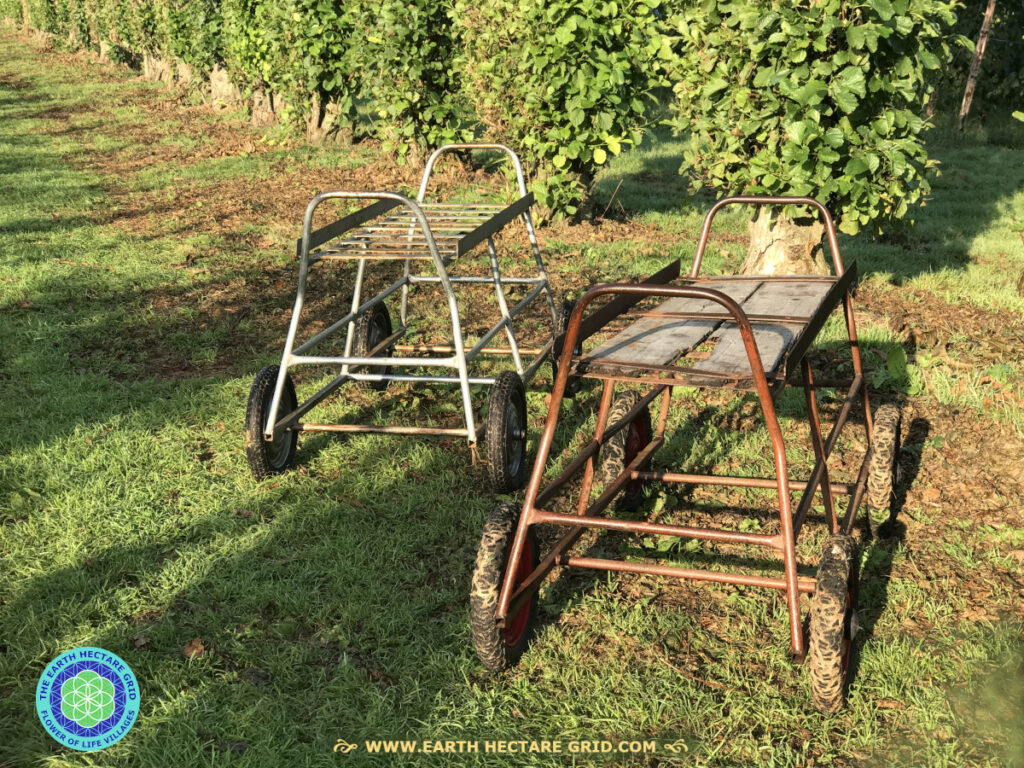
Rodents can be prevented of consuming seeds that are direct seeded. It can be done by protecting the nuts with an empty rusted tin can up side down. A hole in the middle of the reversed bottom lets the plant to grow through in spring. There are also other of such cheap measures.
Larger plant-eating wild animals such as deer can be kept at a distance by stretching iron mesh or gauze around poles surrounding the trees.
WATER MANAGEMENT
Water management is necessary with prolongued drought and/or floods.
When the summers in your area have short or long periods of intense heat, the young trees need to be watered every day or every other day.
For trees that are direct seeded its good to think in advance about an irrigation system.
Can you create water flow on the terrain, such as the incorporation of swales or ditches?
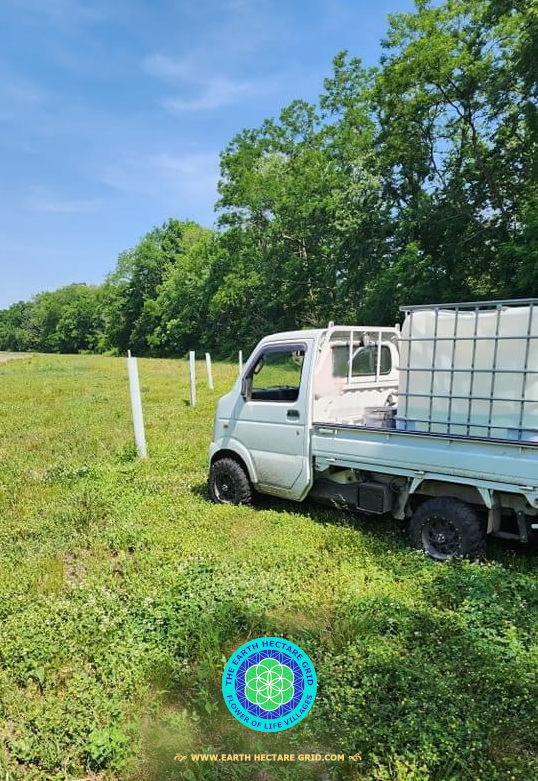
In case one hasn’t a water irrigation system yet, it is possible to water young trees by driving around a large water tank on a truck (picture from the internet). The trees on this land are placed in tree tubes to prevent wildlife browsing their leaves and branches.
Is there a pond where one can tap water from? Can garden hoses and sprinklers be used, possibly using water pumps, or are a number of water pipes laid across the site that are conneted to the house tap?
Especially if there are about two hundred trees, to water them with a watering can might be a bit of an intensive job as in hot summer each tree needs a few buckets of water at a time. The amount of water required for two hundred trees is also difficult to carry with a watering can.

Another method the municipality uses is to place a water bag or sack around the young trees which will leak the water in moderate amounts every day. keeping the soil wet without spilling too much water.
HERE COMES THE SUN
How to protect young trees from intense summer heat? How to build the tree canopy in layers related to the expected heigth of the trees and related to the course of the sun during the day?
What distance should be kept from roads and houses when planting trees? As high as the trees can grow, as far their roots can spread. They might work up even concrete roads. When a tree can become 30 meters high, then use a minimum distance of 30 meters from the house. Also as wide as a tree canopy can grow over the years, as big their shadow can get.
GOOD QUALITY SEEDS
Nowadays there are many large cities in all countries and parts of the world with no surrounding forests. One has to travel by motorized traffic such as car or train for at least half an hour before one can hike in the countryside where natural forests reside.

If these forests have grown and multiplied by themselves you’ll know that these are natural heirloom trees from primeval origin which produce good quality seeds and nuts.
TREES FROM SEED
All trees produce seeds or nuts. They come in all sizes, shapes and forms. Below is a picture of what we would typically describe as seeds. These are seeds from maple trees, also called ‘helicopter seeds’ or ‘winged seeds’. The botanical name for that is ‘Samaras’. There are many maple species though.
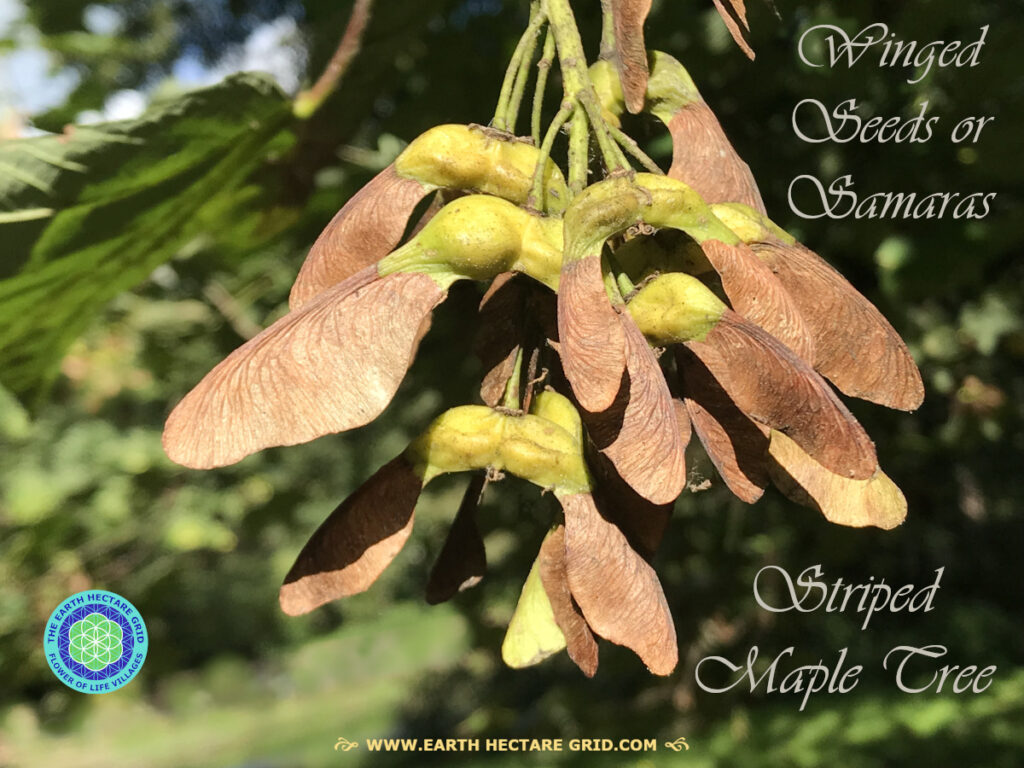
These seeds are most likely from the ‘Striped Maple’ species because its bark is striped. The leaves also point to this tree species, although slightly different than what’s on the net. So this is probably a cultivar. It doesn’t have the sweet sap as the ‘Sugar Maple’ does (would love to grow a few trees of those!), but it is a great browse plant for wildlife.
For fruit trees one might want to look for heirloom trees as well. This means that the same trees can grow from the seeds that their fruits carries within.
Nowadays fruit trees are often genetically manipulated in order to create larger fruits or different species even. Or the trees are grafted on stems of other trees in order to get the same quality fruit as the parent tree. However, this parent tree isn’t the parent really, nor is it to be compared to a brother or sister relationship. It is just a duplicate or clone of itself.
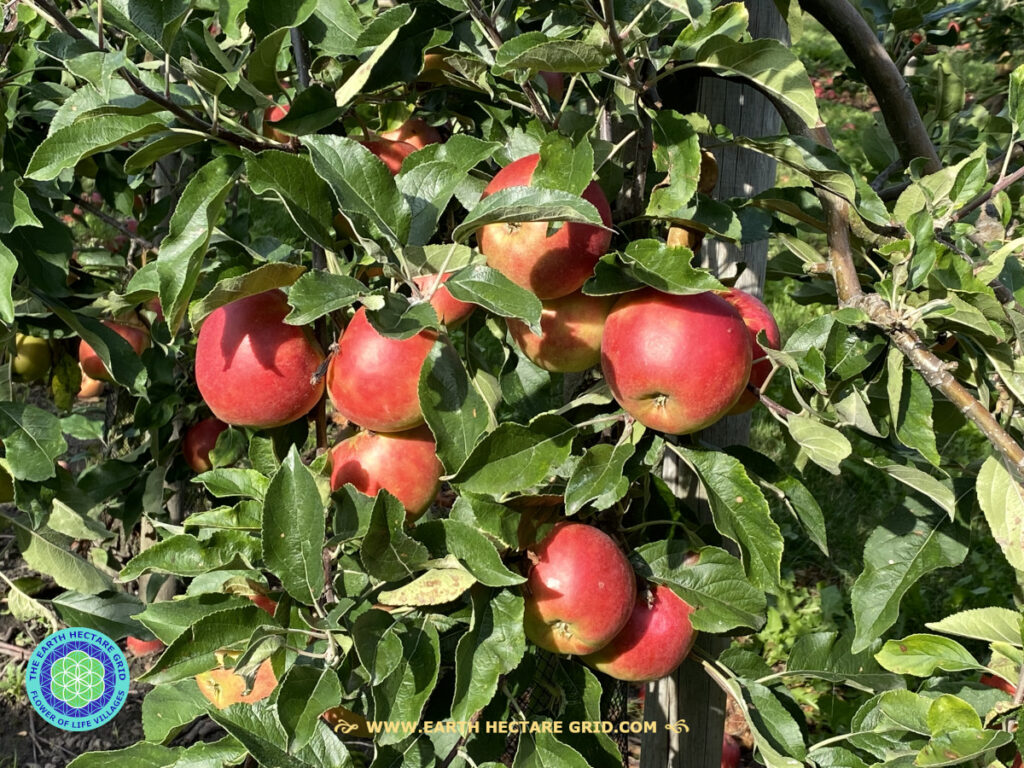
And with this method of fruit producing, the genetic diversity and genetic strength or vigor of the seeds in the fruits will diminish over time, despite producing possibly great fruit. Thats why trees grown from heirloom seeds and nuts are the ultimate goal.
TREES FROM GARDEN CENTERS
The same applies to fruit trees from garden centers. These are usually grafted trees and/or genetically manipulated and hybrid. A hybrid plant is the result of cross-pollinating two different plant varieties with the purpose of collecting the new type of seeds they produce. Plants groing from those seeds are labeled as ‘F1’ which stands for ‘First generation hybrid offspring’. The F1 offspring however is genetically weakened.
HYBRIDS LONG TERM
So if you buy those trees, you’ll have a good garantee that they will produce the desired fruit. But in the long term, your grandchildren will not be able to grow new trees from the seeds of the fruits of those hybrid trees. They will only be left with the timber once the trees stop producing fruit. And then, where to get new heirloom trees? Is there anyone out there protecting the original genes of trees? You see?
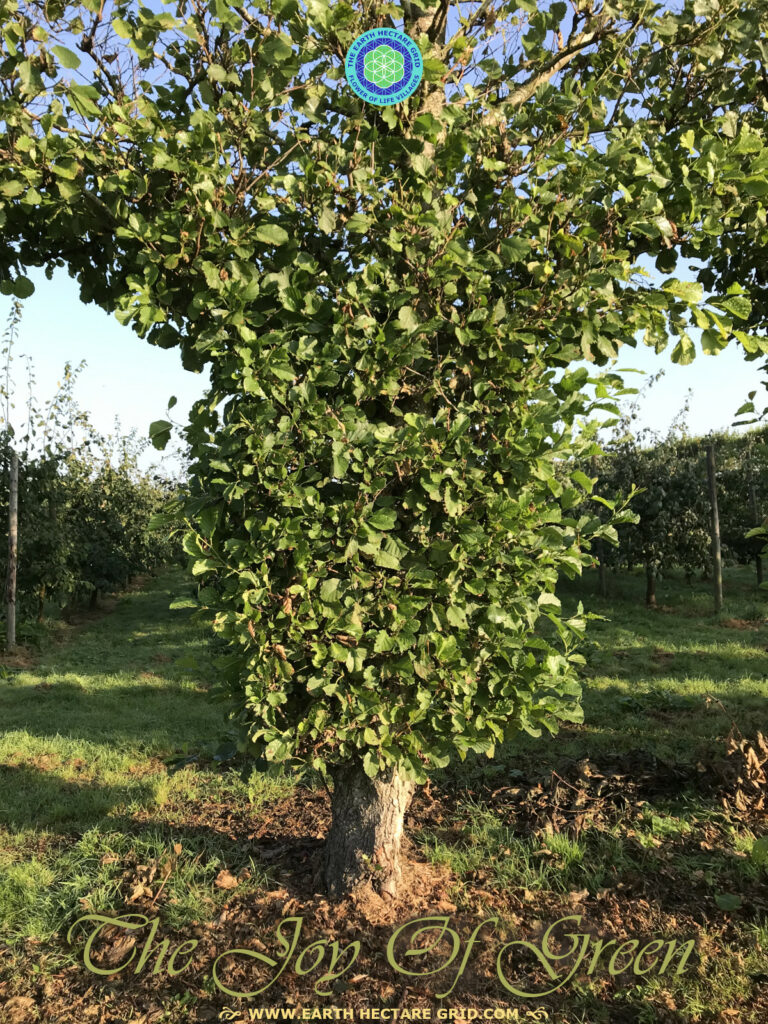
ONE MONTH A YEAR
On top of that there’s only one month a year where one can collect seeds from trees. And most of those trees let their seeds drop in a timespan of two to three weeks. This is where wildlife will collect and consume those seeds in no time, especially all hibernating animals.
So if you live in a vast conglomeration and you’re waiting too long to go to the countryside, all your future dream trees are gone, in the bellies of those lovely birds and squirrels, to be precise.
Thus what is the magic month to collect seeds in autumn? For the Northern Hemisphere this is the end of september and october, for the Southern Hemisphere around may.
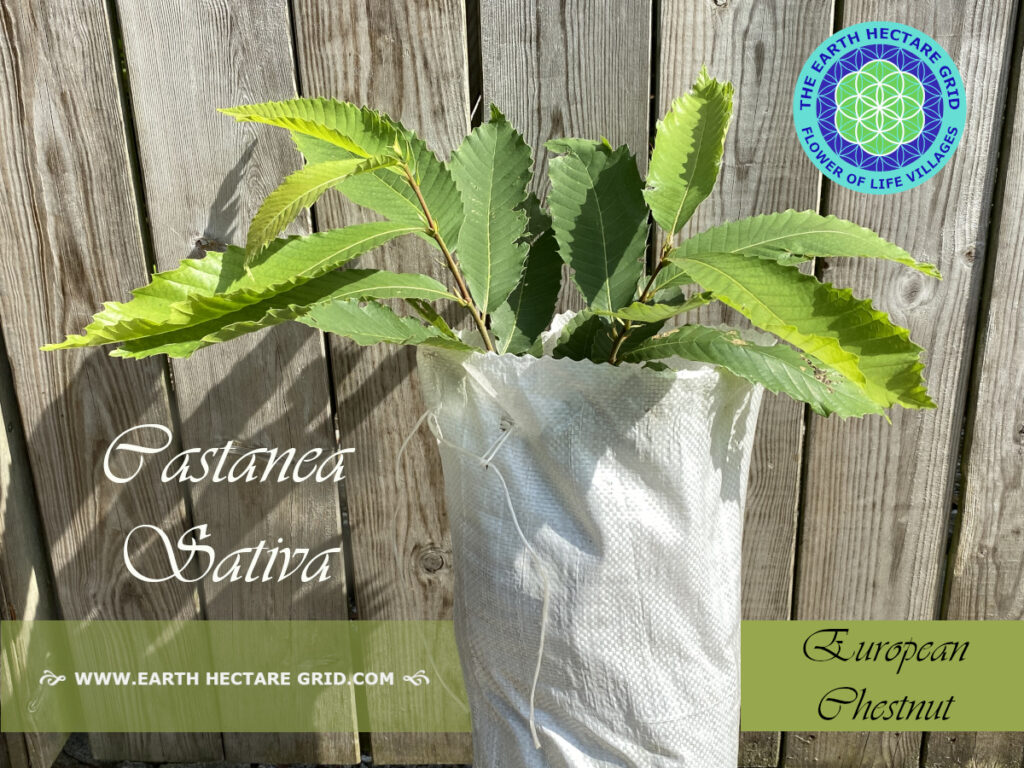
COLD STRATIFICATION
Some tree seeds need cold stratification in winter and will only sprout in spring. For that purpose people place seeds such as walnuts and chestnuts refrigerated, but this is not absolutly necessary. I myself have put these nuts during winter in a shed outdoors. They were in an open container, so the nuts could adapt to the atmosphere.
As I forgot I put the nuts there, in hindsight they were moist enough without me watering them, as well as they were mostly kept cool and in the dark. So accidentally I did it right, but it would be great to check on them next time around because the nuts shouldn’t dry out completely. At the end of winter or early spring one can take them out and plant them, either in pots or direct seeding on the spot where you want the trees to take root and flourish.
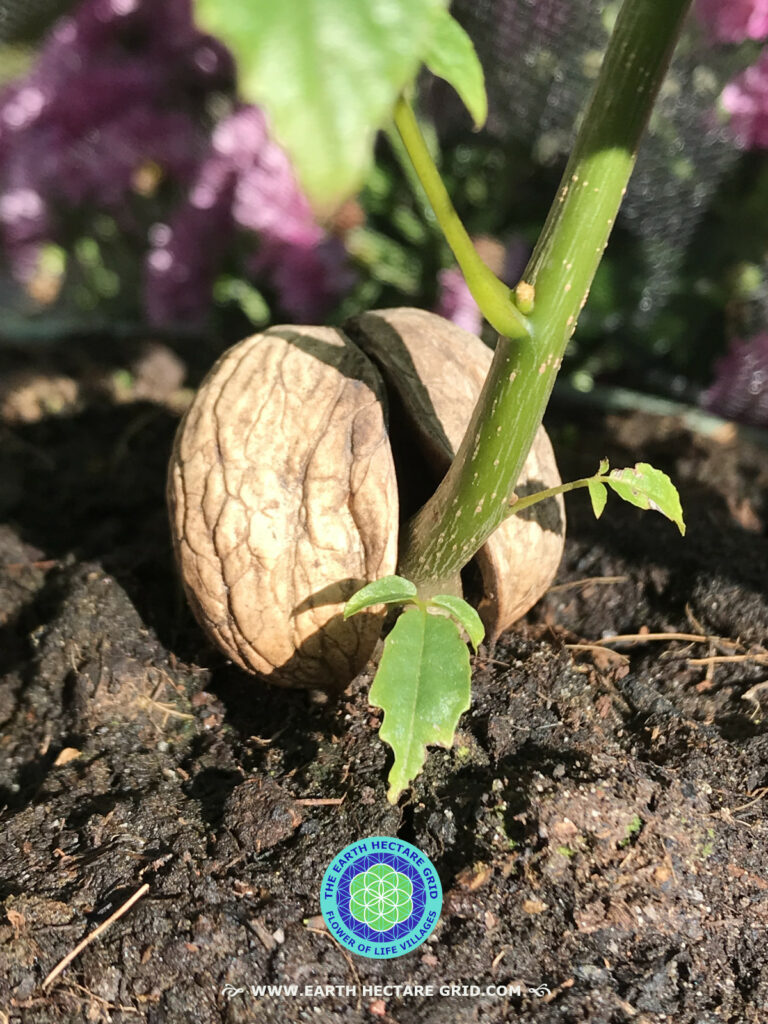
SEEDING IN POTS
The pots or containers must be wide enough for the plant to develop and deep enough for the roots to grow. The problem is I couldn’t find any tall tree pots. The containers that are out there can be tall but are too wide at the same time. This takes up unneccesary space and creates a heavy weight. And they are also very costly. So that isn’t going to work if we want to reforest our planet. They must be cheap but have quality, right?
The design I really love is the ‘vip tree air pots’. Here explained in Dutch, but footage shows it.
Below another video about air pots in English, named Air-PotR U system. They come in different sizes now! Personally I prefer the tall & small ones than the current dimensions.
And too bad they’re so expensive. They’re selling the idea and invention and initial costs of mass production, but it is plastic after all. Nevertheless, love a system that works!
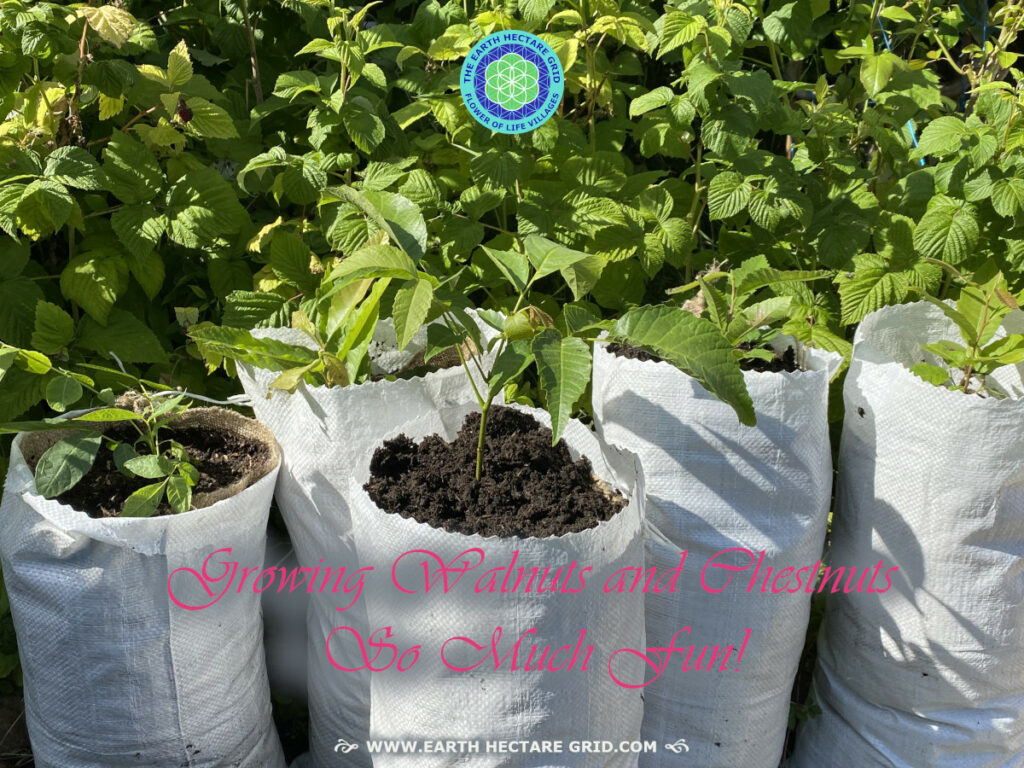
Initially I chose simple sandbags to grow the tree saplings in (depicted above and with this article). The sandbags have a size of 30×60 cm.
They cost under an euro each and are made of PolyPropyleen. Inside I used a jute bag. This jute fabric is loosely woven with holes in the fabric, which ensures good air circulation and air flow for the roots of the plant. However jute desintegrates within half a year, especially after the heavy rain we’ve had this summer. But at least I got the saplings growing well!
I would want containers to be 37cm wide by 70cm tall, or even taller like 75cm and 80cm. Have to experiment with different sizes to find out what works best. The idea is to only grow trees until they’re two to three years old. It is important that the taproot can grow as deep as it wants!
I also thought to use cotton bags instead, or some sort of canvas material to grow the trees in. And it must be organic material. This is because when I cut holes in the bottom of the plastic sandbags, the material started to fray and shred. And I don’t want small particles of plastic in the environment.
D.I.Y. air pots
Nevertheless, plastic tree air pots are favorite. I guess this type of plastic can be recycled endlessly. It would be a great way to give all plastic waste a new life, let it reshape into vip tree air pots!
Air pots might be better for growing trees because they are slightly firmer and protect the roots better. In the video above someone figured out how to create DIY (Do It Yourself) tree airpots with low costs.
Indeed it is somewhat improvisational in my small yard, as I do now have around 30 trees and I want to have more. In these airpots I might be able to stall more trees, but it’ll be some hassle to actually make these pots.
Must admit though it is addictive to grow them. The miracle each time when out of a nut comes a tree plant after a long dark winter, everytime amazes me!

Those saplings are also very cute, aren’t they? Just as all newborns are! So I have been pondering if I can adjust my small yard in such a way that I can actually grow 200 trees for my family domain. But then I have to reconsider my method of growing.
SUFFICIENT DRAINAGE
There must be also a good water drainage in the pots. So at the bottom need to be holes for sufficient drainage. One can also mix the soil with either sand, perlite or vermiculite. This makes water flow easily through the soil. However, sand makes the weight of the tree pot very heavy.
Perlite and vermiculite are natural vulcanic minerals and rock in the form of amorphous glass. When heated up to high temperatures (500C to 800C) it changes in small white grains. These are quite porous and very light in weight. Perlite makes the water run through smoothly.
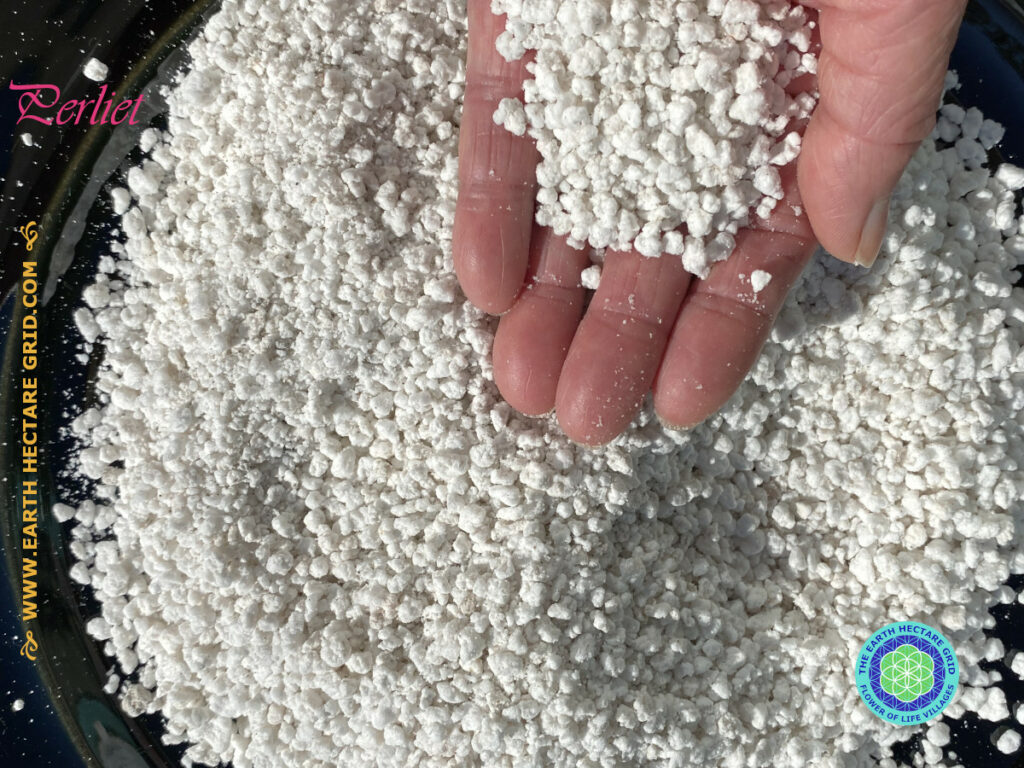
Perlite grains.
Perlite consists of 70% of silicon dioxide. When mixed with clay soil it loosens the soil, and thus improves structure, aeration and water drainage, and also absorbs nutrients a bit.
Vermiculite, has a slightly different texture and is light brown in color. It is also very airy but holds more onto water and nutrients. Because both perlite and vermiculite are very light weight, when tossed around particles of it can nebulize in the air. Be careful not to inhale it or get it in the eyes as it can cause allergic reactions.
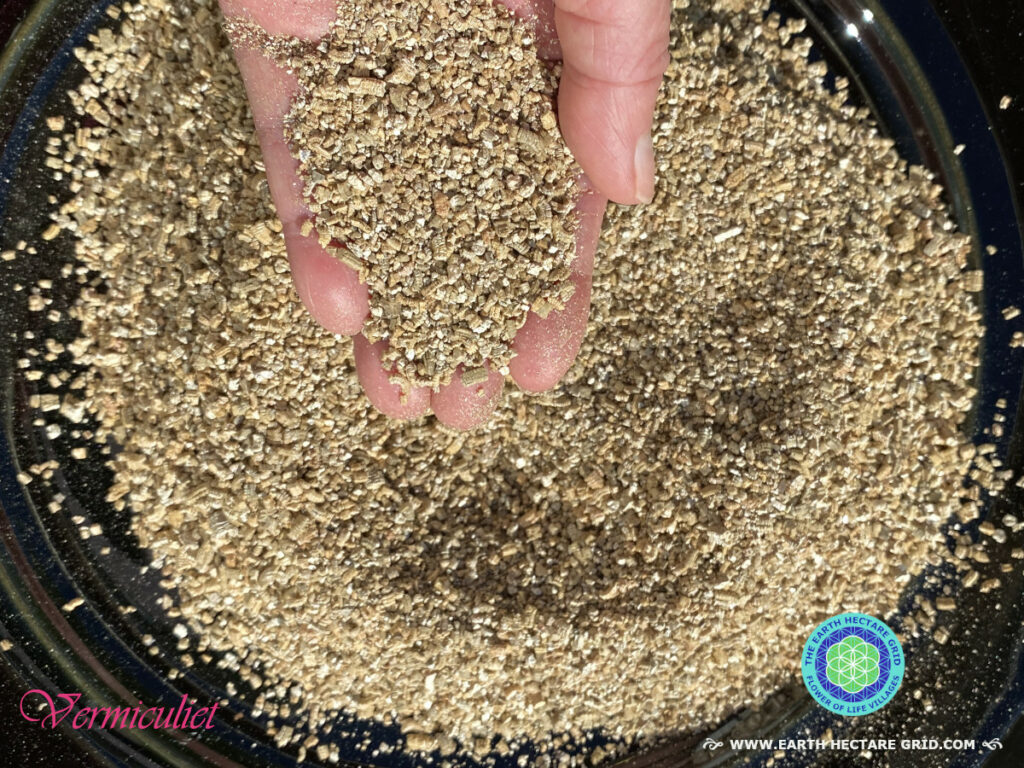
Vermiculite particles
One can put vermiculite in a container with air holes and store nuts therein for stratification. The vermiculite will absorb a little bit of the moisture in the air and regulates ventilation at the same time.
WEEDS IN TREE POTS
Another way to get good drainage in the tree pots or containers is to let weeds naturally grow in them. The weeds grow deep roots in the pots and thus create a better soil structure and water drainage at the same time. When the weeds grow taller than the tree saplings, one can cut the weeds, but don’t pull them out, let their roots stay in. Just allow new weeds to grow.
When there is no good drainage in the containers, they will become very smelly as the soil starts to rot. This is how I found out that weeds are the best natural and cheepest solution!
So why did I do that? This is because I couldn’t find suitable pots to plant them in, as these are all too low for the tree roots to grow deep. Because that’s what seeds from trees do.
TREE NURSERY
This is where I’m now dreaming of a tree nursery where I can protect the tree saplings from the vagaries of weather. But they would still be in an outdoor open space with light coming in through the transparent roof. Contemplating further, it would be even more perfect if I could start a tree nursery ON my family domain. Haha, lol! Oh well.
Margreet Wilschut
Back to the MENU

